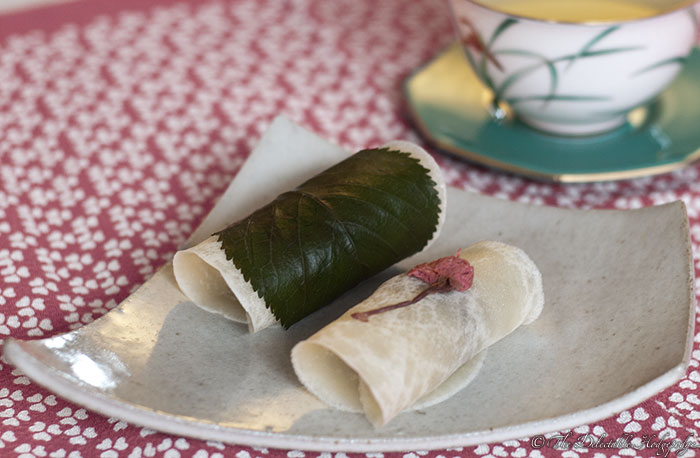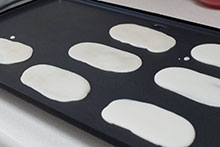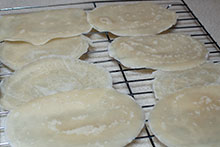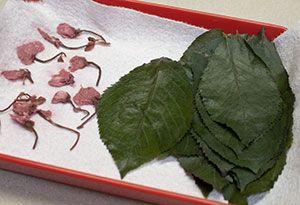
Sakuramochi
| Ingredient | 15 rolls | 15 rolls |
|---|---|---|
| pastry flour | ¾ cup | 90g |
| shiratamako (sweet rice flour) | 1½ tsp. | 1½ tsp. |
| water | ½ cup | 120 ml |
| sugar | 4½ Tbsp. | 60g |
| koshian | 1 lb. | 450g |
| preserved sakura leaves | 15 leaves | 15 leaves |
| preserved sakura blossoms (optional) | 15 blossoms | 15 blossoms |
| vegetable oil | as needed | as needed |
Sakuramochi, meaning “cherry blossom mochi,” is a confection something like a miniature Japanese crepe. This Kanto variation is composed of a piece of mochi dough wrapped around a dollop of anko and topped with a fragrant sakura leaf. Don’t be fooled by the appearance of the leaf; preserved sakura leaves have a delicate texture and taste distinctly floral, not at all like the greenery they appear. The resulting blend of spring perfume and soft textures is often eaten at sakura viewing parties or on Girls’ Day, but you can enjoy the elegant evocation of the season whenever and wherever you eat this very Japanese treat.
Preparation
- Prepare one batch of koshian.
- Divide the anko into 15 balls of 30g (1 oz) each and set aside.
- Rinse the leaves then soak them in water for about 10 minutes. Blot dry with a paper towel.
- If using sakura blossoms, rinse off the salt and let them soak in a bowl of water for 5 minutes. Remove from water and dry by pressing gently in a paper towel.
Directions
- Mix water and shiratamako.
In a small bowl dissolve the shiratamako in 1 tsp. of the water and mix thoroughly. Add the remaining water a little at a time, mixing each time to avoid forming lumps. - Mix with flour and sugar.
Sift the sugar and pastry flour together into a medium bowl. Add the shiratamako mixture a little at a time, stirring with a whisk to mix thoroughly. - Cook coverings.
 Heat a griddle to 140°C (300°F) and grease lightly with vegetable oil. Pour 1 Tbsp. of batter onto the griddle and use the back of the spoon to smooth it into an oblong shape, about 7 cm by 12 cm (a little less than 3" by 5"). Repeat the process until you run out of space or the first one begins to solidify.
Heat a griddle to 140°C (300°F) and grease lightly with vegetable oil. Pour 1 Tbsp. of batter onto the griddle and use the back of the spoon to smooth it into an oblong shape, about 7 cm by 12 cm (a little less than 3" by 5"). Repeat the process until you run out of space or the first one begins to solidify. - Flip and cool.
 When the top surface of the batter solidifies, flip it over. Cook briefly on this side, until it solidifies, then remove from the griddle and place on a cake rack to cool. Avoid browning either side; you only want to cook it lightly. Repeat as necessary with remaining batter.
When the top surface of the batter solidifies, flip it over. Cook briefly on this side, until it solidifies, then remove from the griddle and place on a cake rack to cool. Avoid browning either side; you only want to cook it lightly. Repeat as necessary with remaining batter. - Roll.
Roll one sheet around each ball of anko, with the side you cooked first on the outside; wrap firmly enough to form an open-ended cylinder. Wrap one sakura leaf around each roll, with the bottom side of the leaf on the outside. If using cherry blossoms place one on top of each roll and serve.
Notes
- You can add a preserved cherry blossom to the top of each roll as decoration, or replace the leaf entirely with a blossom. Note that the leaves actually have a stronger floral flavor than the blossoms.
- The mochi in sakuramochi is often dyed a pale pink color to match the color of a cherry blossom; you can add a small drop of red food coloring to the batter if you want.
- If you don’t have a griddle, you can use a nonstick frying pan over low heat.
- Tsubuan can be used instead of koshian if you prefer it.
 You should be able to find preserved sakura leaves and blossoms at Japanese specialty markets. It is also possible to make them yourself, if you have access to a tree. Special thanks to Toshie, who preserved the leaves that we used.
You should be able to find preserved sakura leaves and blossoms at Japanese specialty markets. It is also possible to make them yourself, if you have access to a tree. Special thanks to Toshie, who preserved the leaves that we used.

